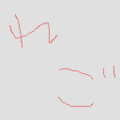LEGO Fun to Build: Difference between revisions
table nonsense |
m i dont remmeber what i did here |
||
| Line 158: | Line 158: | ||
=== Prototype versions === | === Prototype versions === | ||
[[File:Fun to Build p1 placeholder.png |thumb| Placeholder Town page from an early build]] | [[File:Fun to Build p1 placeholder.png |thumb| Placeholder Town page from an early build]] | ||
On 30 March 2008, two early builds of ''Fun to Build'' were released on the video game preservation website Hidden Palace. The builds were part of a collection of Pico prototype [[Wikipedia:EPROM|EPROMs]] supplied by video game hardware developer [[Wikipedia:Kevin Horton|Kevin "Kevtris" Horton]].<ref name="DRX lot"/> The ROM headers of both prototypes label them as ''Crayon Shin-chan no Oekaki Note'', a Pico game developed by [[Wikipedia:Bandai|Bandai]] based on the ''[[Wikipedia:Crayon Shin-chan|Crayon Shin-chan]]'' manga; the two prototypes were mislabeled as prototypes of this game on Hidden Palace as a result.<ref name="Hidden Palace proto A"/><ref name="Hidden Palace proto C"/> As the ''Crayon Shin-chan'' game's header date of January 1995<ref name="crayon"/> is also copied in both ''Fun to Build'' prototypes, their actual build dates are unknown.<ref name="Hidden Palace proto A"/><ref name="Hidden Palace proto C"/> | |||
Both builds use a placeholder title screen featuring a hand-drawn [[Wikipedia:Hiragana|hiragana]] LEGO logo.{{efn|As a foreign-language word, ''Lego'' in Japanese is usually written with [[Wikipedia:Katakana|katakana]] {{nihongo||レゴ}} instead of hiragana {{nihongo||れご}}.}} The later build (labeled Prototype A/1 on Hidden Palace) is similar to the final build; some differences include different camera panning behavior, missing or different music and sound effects, and an incomplete Building page screen. The earlier build (labeled Prototype C/3) is very incomplete: no minigames are accessible, there is no music, and placeholder photographs are used in place of several page screens. The Building page screen features four sample models which can be rotated and will build one brick at a time when loaded. | Both builds use a placeholder title screen featuring a hand-drawn [[Wikipedia:Hiragana|hiragana]] LEGO logo.{{efn|As a foreign-language word, ''Lego'' in Japanese is usually written with [[Wikipedia:Katakana|katakana]] {{nihongo||レゴ}} instead of hiragana {{nihongo||れご}}.}} The later build (labeled Prototype A/1 on Hidden Palace) is similar to the final build; some differences include different camera panning behavior, missing or different music and sound effects, and an incomplete Building page screen. The earlier build (labeled Prototype C/3) is very incomplete: no minigames are accessible, there is no music, and placeholder photographs are used in place of several page screens. The Building page screen features four sample models which can be rotated and will build one brick at a time when loaded. | ||
Revision as of 12:14, 3 October 2024
| LEGO Fun to Build | |
|---|---|
 Front case cover | |
| Developer(s) | Easy Computer System |
| Publisher(s) | Sega |
| Producer(s) | Akemi Kamata[1]: 6 |
| Platform(s) | Kids Computer Pico |
| Release | |
| Genre(s) | Edutainment |
| Mode(s) | Single-player |
LEGO Fun to Build[a] is a 1995 educational children's game developed by Easy Computer System and published by Sega for the Kids Computer Pico. Released exclusively in Japan in December in 1995, it is the first official LEGO video game, predating LEGO Island by nearly two years.
Gameplay
LEGO Fun to Build is an activity center game. thing. Control with stylus and stuff.[4]: 4 It has four sections: Town, Aquazone, Castle, and Space, each accessed by turning pages in the Storyware cartridge. The Pico book. "Assembly events"?
Pages:
| Header text | Header text |
|---|---|
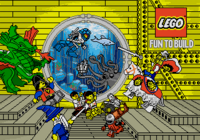 |
The game's title screen. It features no activities. |
| Town (街シリーズ) | |
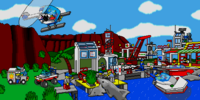
|
The Town page features sets from the LEGO Town theme from 1994 and 1995. The scene takes place at a busy harbour home to the Coast Guard Headquarters and Leisure Port Marina. It features terrestrial, aquatic, and aerial vehicles, which are used in this page's assembly events. There are five assemblies:
There are two minigames on this page: the Racing game and the Pizza Delivery game. The former can be accessed by building the speedboat, while the latter can be by building the pizza car.[4]: 8–9
|
| Aquazone (アクアゾーン) | |
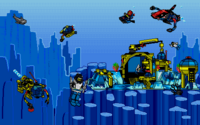
|
The Aquazone page features sets from the Aquanauts and Aquasharks lines.[4]: 12–13
|
| Castle (お城シリーズ) | |

|
Castle[4]: 16–17
|
| Space (宇宙シリーズ) | |
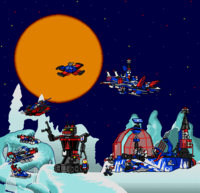
|
The Space page features sets from the LEGO Space theme's Ice Planet 2002 and Spyrius lines. The scene is set in the distant future on Ice Planet, where a space base is being targetted by Spyrius ships. This page features six assemblies:[4]: 20–21
|
| Building games (組み立て遊び) | |
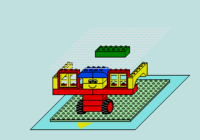
|
boo |
Minigames
| Header text | Header text |
|---|---|
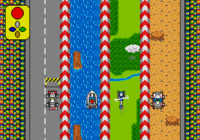
|
Racing game (レースゲーム) |
| The Racing game is accessed by selecting and assembling the Speedboat from the picture book. The player selects one of four vehicles and races three CPU opponents. If the player finishes in the top two they advance to the finals in a one-on-one race.[4]: 10 | |
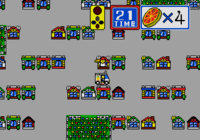
|
Pizza delivery game (ピザ配達ゲーム) [4]: 11 |
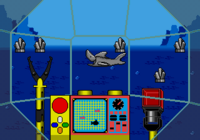
|
Aqua Crystal Exploration Vessel game (アクアクリスタル探査艇ゲーム) [4]: 14 |
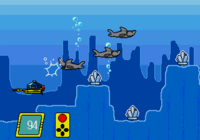
|
Aqua Mini Submarine game (アクアミニサブマリンゲーム) [4]: 15 |
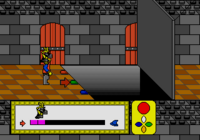
|
Castle maze game (お城迷路ゲーム) [4]: 18–19 |
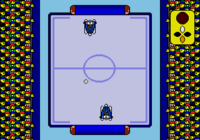
|
Ice Planet Mogul game (アイスプラネットモーグルゲーム) [4]: 22 |
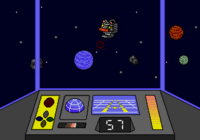
|
Twin Falcon game (ツインファルコンゲーム) [4]: 23 |
Development and release
LEGO Fun to Build was produced at Sega Enterprises for the educational Kids Computer Pico console (known internationally as the Sega Pico). The game was designed for children between the ages of three and six. Akemi Kamata headed its production; Kamata thought that a game featuring LEGO bricks would work well on the Pico, believing that LEGO naturally fostered creativity. She later said about it, "I thought that if I could make my favorite LEGO bricks that could be played with interactively through a TV, children's dreams would spread."[1]: 5–6 The game was programmed by the "AM" (Amusement) division[note 1] of Easy Computer System (ECOS),[5] a Japanese software company that developed dozens of Pico games for Sega.[6][7] Many of the in-game graphics are based on 1995 art assets from the marketing agency Advance; the game's box art and Storyware pages directly use photographs from these assets.[8] Programming was completed during October 1995,[9] and the game was released in Japan in December 1995.[2]
Prototype versions
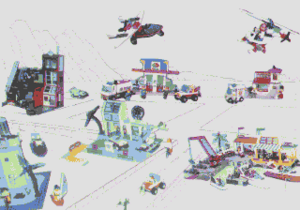
On 30 March 2008, two early builds of Fun to Build were released on the video game preservation website Hidden Palace. The builds were part of a collection of Pico prototype EPROMs supplied by video game hardware developer Kevin "Kevtris" Horton.[10] The ROM headers of both prototypes label them as Crayon Shin-chan no Oekaki Note, a Pico game developed by Bandai based on the Crayon Shin-chan manga; the two prototypes were mislabeled as prototypes of this game on Hidden Palace as a result.[11][12] As the Crayon Shin-chan game's header date of January 1995[13] is also copied in both Fun to Build prototypes, their actual build dates are unknown.[11][12]
Both builds use a placeholder title screen featuring a hand-drawn hiragana LEGO logo.[b] The later build (labeled Prototype A/1 on Hidden Palace) is similar to the final build; some differences include different camera panning behavior, missing or different music and sound effects, and an incomplete Building page screen. The earlier build (labeled Prototype C/3) is very incomplete: no minigames are accessible, there is no music, and placeholder photographs are used in place of several page screens. The Building page screen features four sample models which can be rotated and will build one brick at a time when loaded.
-
Placeholder LEGO (れご) logo
-
Placeholder Castle page
-
Placeholder Space page
-
Test Building page (house foundation)
-
Test Building page ("ECOS")
-
Test Building page (four doors)
-
Test Building page (quarter pyramid)
Legacy
Despite being the first LEGO video game, Fun to Build has remained obscure compared to later titles such as LEGO Island, and little is known about its development. In December 2020, the LEGO Group launched the podcast Bits N' Bricks to celebrate the 25th anniversary of LEGO video games, based on the release of Fun to Build.[14] The game was only briefly discussed in episode 17, however, where Akemi Kamata was revealed to be its producer. Journalist Brian Crecente, one of the podcast's co-hosts, contacted Kamata and learned about her involvement in the game, though Kamata did not appear as a guest participant on the podcast.[1]: 5–6
Notes
References
- ↑ a b c Crecente, Brian; Vincent, Ethan (31 March 2021). "Episode 17 – LEGO Video Games and Digital Play" (PDF). Bits N' Bricks (Podcast). Participants: Niels B. Christiansen, Julia Goldin, and Sean McEvoy. The LEGO Group. Archived (PDF) from the original on 15 May 2024. Audio version via YouTube.
- ↑ a b "From Bricks to Bits: The LEGO Group Celebrates 25 Years of LEGO Video Games" (Press release). Billund: The LEGO Group. 2 December 2020. Archived from the original on 2021-01-17. Retrieved 2024-05-15.
- ↑ LEGO Fun to Build (Media notes) (in Japanese). Sega. December 1995. Spine. Archived from the original on 2024-09-17.
- ↑ a b c d e f g h i j k l LEGO Fun to Build ガイドブック [LEGO Fun to Build Guidebook] (PDF) (in Japanese). Sega Enterprises Ltd. 1995. Archived (PDF) from the original on 14 February 2024.
- ↑ Easy Computer System (1995). LEGO Fun to Build (Sega Pico) (early prototype ed.). Sega. Scene: Building game test models.
ECOS
- ↑ "AM事業部 あしあと" [AM Division Footprint]. ecos.co.jp (in Japanese). Archived from the original on 1997-05-28.
セガ・エンタープライゼス 【キッズコンピュータ・ピコ】(絵本ソフト約60本)
[Sega Enterprises – [Kids computer pico] (approximately 60 picture book software)] - ↑ "AM事業部 業務内容" [AM Division Business Contents]. ecos.co.jp (in Japanese). Archived from the original on 1997-05-28.
- ↑ emily/Pereki (2 January 2015). "The entire game is based almost exclusively on 1995 art assets from Advance". Rock Raiders United (Comment in topic "LEGO Fun to Build: The first LEGO game?"). Archived from the original on 19 January 2019.
- ↑ Easy Computer System (December 1995). LEGO Fun to Build (Sega Pico). Sega. File/code: ROM header, offset 00000100.
SEGA PICO – (C)SEGA 1995.OCT – LEGO—FUN TO BUILD – LEGO—FUN TO BUILD – HPC-6032-00
- ↑ "Ecco 2, Nightmare Circus, X-Perts..." Hidden Palace. March 30, 2008. Archived from the original on 2024-09-16.
- ↑ a b "Crayon Shinchan Oekaki Note (Prototype A)". Hidden Palace. Archived from the original on 2024-09-16.
- ↑ a b "Crayon Shinchan Oekaki Note (Prototype C)". Hidden Palace. Archived from the original on 2024-09-16.
- ↑ Bandai (January 1995). Crayon Shin-chan no o-Ekaki Nōte (Sega Pico). File/code: ROM header, offset 00000100.
SEGA PICO – (C)T-1331995.JAN – CRAYON SHINCHAN – OEKAKI NOTE – T-133080-00
- ↑ "From Bricks to Bits: The LEGO Group Celebrates 25 Years of LEGO Video Games". LEGO.com (Press release). Billund, Denmark: The LEGO Group. 2 December 2020. Archived from the original on 15 August 2022.
External links
- Lego Fun to Build at Sega Retro
- LEGO Fun to Build at MobyGames
Cite error: <ref> tags exist for a group named "note", but no corresponding <references group="note"/> tag was found





















